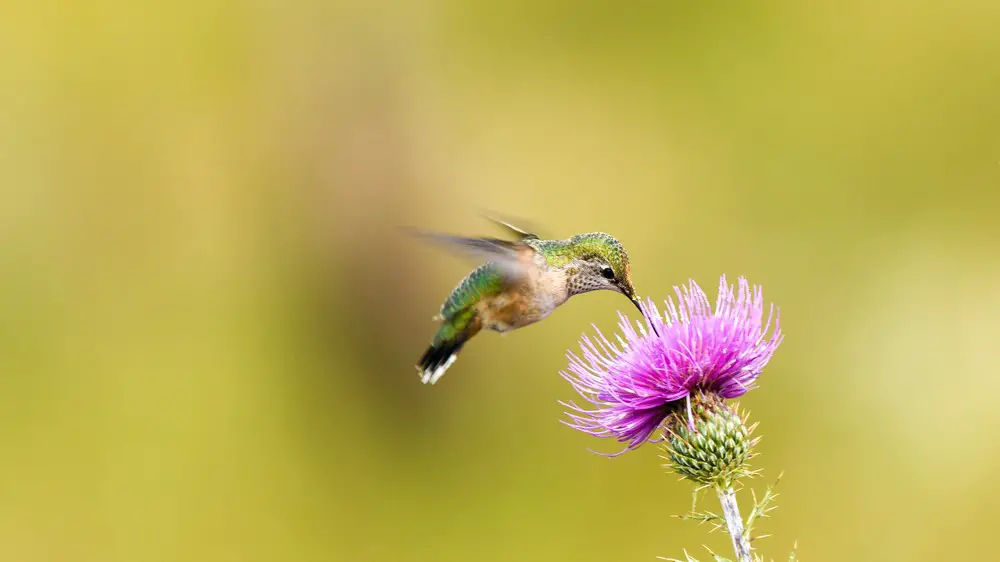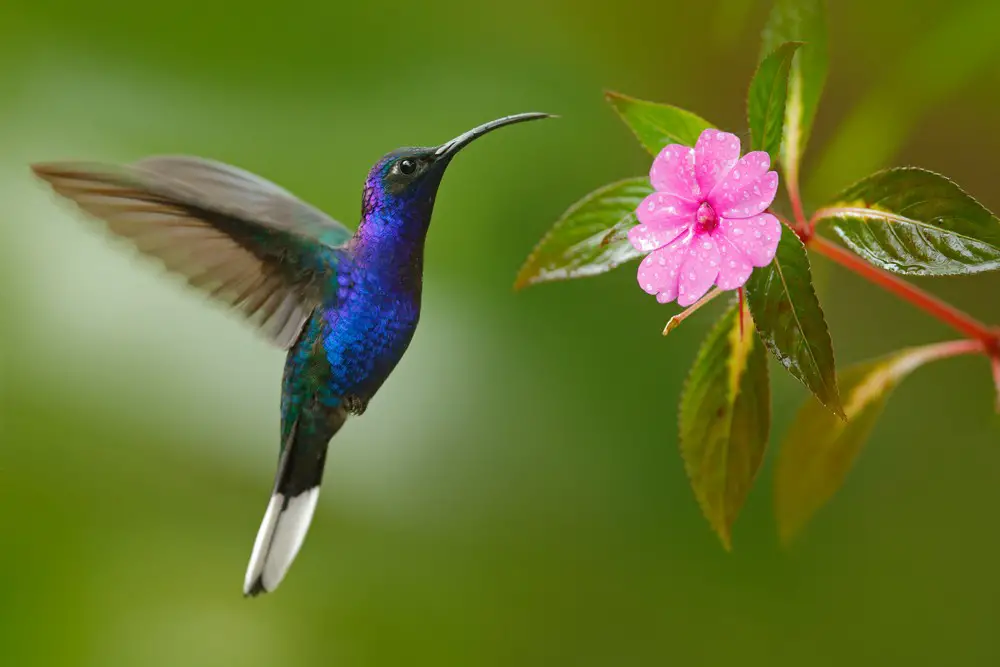If you’ve ever had the pleasure of interacting with a hummingbird, you know they have a sweet spot for nectar. These curious and cute fluttering feather friends flit around flowers to find them. They also nudge their long, narrow beaks into a feeder laid out by a human. This can contain manufactured concentrates or homemade sugar water.
But did you know that nectar isn’t the only thing on their daily menu?
So, what do hummingbirds eat? They have to consume a wide range of protein, vitamins, minerals, salts, and calcium. These things come from a variety of food like fresh fruit juices, insects, bee pollen, and even ash or sand.
As a matter of fact, hummingbirds have to eat all day long to maintain the massive reserves energy they use for flying and acquiring resources.
Nectar Isn’t Nutritious Enough
Unfortunately, nectar, although delicious to hummingbirds, doesn’t offer a complete and well-balanced diet.
They require protein, amino acids, and other minerals and vitamins to stay fit and healthy.
There are many things they consume to maintain a healthy weight and a lively disposition.
Insects Are Yummy For Hummingbirds
Most of what hummingbirds eat are insects, dozens of them per day in fact.
If they’re caring for a brood of hatchlings, this can amount to three to five times more.
Insects are an essential source of protein and provide necessary salt, minerals, vitamins, and fat for hummingbirds.
Gnats, aphids, wasps, spiders, larvae, and eggs are often a large part of a meal.
They grab them from plants and flowers with sticky saps, snatch them from a spider’s web or catch them midair with ninja-like precision.
Nectar is more like a beverage to wash these down or as a dessert.
Trees, Flowers & Fruits

If flowers or other sources of nectar aren’t readily available, then they’ll sip on tree saps.
That’s because tree saps, like pine and maple, contain the amino acids and natural sugars hummingbirds must-have. They provide adequate nutrition and have the capacity to attract insects.
Hummingbirds are famous for sipping at fresh fruit juices from the exposed flesh of berries, apples, prickly pears, and other fruits.
Fruit juice is high in the natural sugars they love so much and provide an excellent energy source.
Exposed fruit skins also attract the bugs hummingbirds love to eat.
A Bit About Bee Pollen
Another source of hummingbird food is bee pollen. Although not a common item in their daily diets, they do to eat it.
Pollen has some protein and minerals useful to hummingbirds. It’s likely they get pollen from the flowers they frequent.
This is what makes them part of the star lineup of botanical pollinators for landscapes and gardens.
Other Vitamin-Mineral Sources
There are some reports of hummingbirds nipping at small piles of ash, grit, and fine sand. It’s likely they are digging out small insects.
But they are getting valuable and essential nutrients into their diet, like calcium, salt, and other minerals.
Feeding Hummingbirds
If you wish to attract hummingbirds to your garden, you want to leave a savory buffet fit for a king, in hummingbird cuisine that is.
Make sure you offer a variety of enticing foods to suit their varying palettes for what hummingbirds eat.
Yes, have nectar – you can even make your own – but be sure to cover all their nutritional requirements.
What NOT To Do
Make sure you refrain from using insecticides and other harsh chemicals around feeders and flowerbeds.
If you want them to have fresh fruit juice, don’t set out bottled or canned juices.
These often contain dyes, artificial colors, chemical preservatives, and manufactured sweeteners that can harm hummingbirds.
Also, don’t tear down active cobwebs.
Growing Plants For Hummingbirds
There are a variety of trees, plants, flowers, and vines you can grow to help attract the presence of hummingbirds.
The following is a shortlist of flowers that produce a lovely and sticky nectar hummingbird can’t resist:
- Begonias
- Columbines
- Fuchsias
- Hollyhocks
- Geraniums
- Impatiens
- Petunias
- Azaleas
- Morning Glories
- Honeysuckles
Plant Some Trees
Plant sugar maple trees and others that attract woodpeckers. The woodpeckers, specifically sapsuckers, will drill holes that hummingbirds can use as feeding areas.
Other trees include crabapples, eucalyptus, and tulip poplars. Sweet fruit trees like apple, pear, and mulberry or bushes like blueberry, strawberry, or blackberry will also attract hummingbirds.
Providing Protein; Other Nutrients
Likewise, you can place a small dish of orange pieces, chunks of watermelon, or mashed banana to bring insects closer to your hummingbird feeder.
But be sure to keep your feeder away from your home to prevent pesky insect invasions.
Also, place a small dish of powdery sand, ash with high salt content, or some other fine grit near their feeder.
Sprinkling some in a flowerbed may also be a good idea so they can reach it if they want. Do not add salt to your dust of choice.
Make Your Own Nectar
If you decide to make your own nectar with sugar water, make sure you use pure white cane sugar or beet sugar and spring water or filtered tap water. No other types of sugar or water will do.
Make sure the sugar has as many impurities and molasses taken out of it as possible.
Molasses is high in iron, which is great for people but toxic to hummingbirds.
Stay away from brown sugar, turbinado sugar, and organic sugar. Don’t use honey, artificial sweeteners, or red food coloring.
A Nectar Recipe
Bring 4 cups of spring water to a boil and add 1 cup of sugar.
Make sure the sugar granules are completely dissolved and allow them to cool. Once cold to the touch, you can add it to your hummingbird feeder.
You can store excess sugar water in the refrigerator for up to one week. Make sure you change out the solution every three to five days to prevent spoilage.
Troubleshooting Feeder Issues
If you are attracting too many bees, use five cups of water per one cup of sugar. Failing that, a bee issue could be a design flaw with your feeder.
Most often, there’s a gap of air between the feeder portal and the liquid below it. You may need to build or buy a new one.
Closing Up For The Winter
In the fall, it’s time to dismantle your summer hummingbird cuisine. But you want to wait until you haven’t seen one for three weeks before taking it down.
Sometimes, there are late migrants, and you want to reduce any risks to their survival, especially with it getting colder. It is important that they remain well-fed and warm.
Hummingbirds Are Nature’s Charming Mystery
Interacting with a hummingbird is magical, providing joy and cheer, beauty, and charm.
When you witness their diminutive, brightly colored bodies and quick, buzzing wings, nature’s enchanting mystery becomes tactile.
Their presence is a daily blessing.
Determining what hummingbirds eat will help you plan how to attract these lovely little winged creatures to your garden.
Being smart about having a variety of nutrients available will not only allow you to enjoy them when they do arrive, but you can actually use the hummingbirds to keep insects away from your house.


